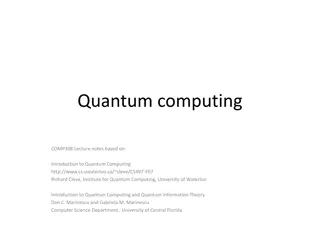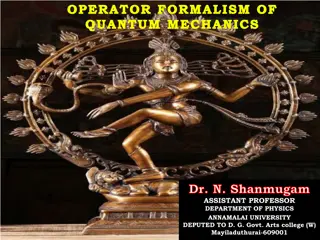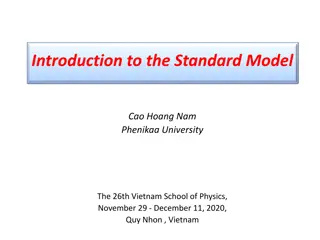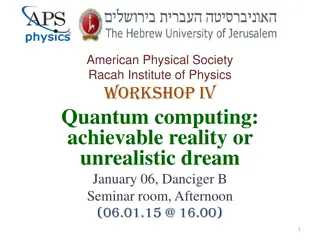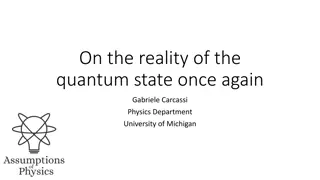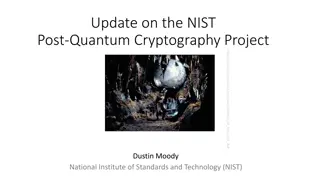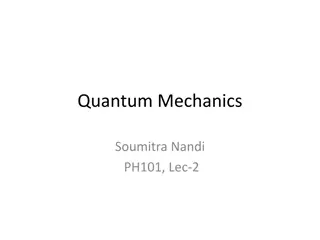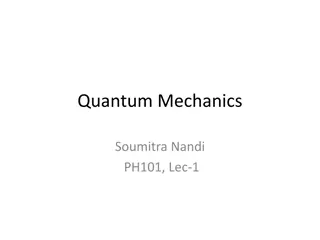Exploring Quantum Mechanics: Illusion or Reality?
Delve into the fascinating realm of quantum mechanics with Prof. D. M. Parshuramkar as he discusses the contrast between classical and quantum mechanics. Discover how classical mechanics fails to predict the behavior of electrons in atoms and molecules, leading to the development of quantum mechanics with its unique features and equations. Explore the distinctions between particles and waves, the continuum of energy states, and the precise trajectories in classical mechanics contrasted with the uncertainty principle in quantum mechanics.
Download Presentation

Please find below an Image/Link to download the presentation.
The content on the website is provided AS IS for your information and personal use only. It may not be sold, licensed, or shared on other websites without obtaining consent from the author. Download presentation by click this link. If you encounter any issues during the download, it is possible that the publisher has removed the file from their server.
E N D
Presentation Transcript
QUANTUM MECHANICS- Illusion or Reality ? Prof. D. M. Parshuramkar Dept. of Physics N. H. College, Bramhapuri
1. Classical Mechanics Do the electrons in atoms and molecules obey Newton s classical laws of motion? We shall see that the answer to this question is No . This has led to the development of Quantum Mechanics we will contrast classical and quantum mechanics.
1.1 Features of Classical Mechanics (CM) 1) CM predicts a precise trajectory for a particle. velocityv position r = (x,y,z) The exact position (r)and velocity (v) (and hence the momentum p = mv) of a particle (mass = m) can be known simultaneously at each point in time. Note: position (r),velocity (v) and momentum (p) are vectors, having magnitude and direction v = (vx,vy,vz).
2) Any type of motion (translation, vibration, rotation) can have any value of energy associated with it i.e. there is a continuum of energy states. 3) Particles and waves are distinguishable phenomena, with different, characteristic properties and behaviour. Property Behaviour Particles Waves mass position velocity wavelength frequency momentum collisions diffraction interference
1.2 Revision of Some Relevant Equations in CM Total energy of particle: E = Kinetic Energy (KE) + Potential Energy (PE) T - depends on v V - depends on r V depends on the system e.g. positional, electrostatic PE E = mv2 + V E = p2/2m + V (p = mv) Note: strictly E, T, V (and r, v, p) are all defined at a particular time (t) E(t) etc..
Consider a 1-dimensional system (straight line translational motion of a particle under the influence of a potential acting parallel to the direction of motion): Define: position velocity momentum r = x v = dx/dt p = mv = m(dx/dt) PE force V F = (dV/dx) Newton s 2nd Law of Motion F = ma = m(dv/dt) = m(d2x/dt2) acceleration Therefore, if we know the forces acting on a particle we can solve a differential equation to determine it s trajectory {x(t),p(t)}.
1.3 Example The 1-Dimensional Harmonic Oscillator x = 0 F NB assuming no friction or other forces act on the particle (except F). k m x The particle experiences a restoring force (F) proportional to its displacement (x) from its equilibrium position (x=0). F = kx Hooke s Law k is the stiffness of the spring (or stretching force constant of the bond if considering molecular vibrations) k Substituting F into Newton s 2nd Law we get: m(d2x/dt2) = kx a (second order) differential equation
Solution: = k x(t) = Asin( t) position of particle m 1 k = /2 = frequency (of oscillation) m 2 Note: Frequency depends only on characteristics of the system (m,k) not the amplitude (A)! x time period = 1/ +A t A
Assuming that the potential energy V = 0 at x = 0, it can be shown that the total energy of the harmonic oscillator is given by: E = kA2 As the amplitude (A) can take any value, this means that the energy (E) can also take any value i.e. energy is continuous. At any time (t), the position {x(t)} and velocity {v(t)} can be determined exactly i.e. the particle trajectory can be specified precisely. We shall see that these ideas of classical mechanics fail when we go to the atomic regime (where E and m are very small) then we need to consider Quantum Mechanics. CM also fails when velocity is very large (as v c), due to relativistic effects.
1.4 Experimental Evidence for the Breakdown of Classical Mechanics By the early 20th century, there were a number of experimental results and phenomena that could not be explained by classical mechanics. a) Black Body Radiation (Planck 1900) UV Catastrophe Classical Mechanics (Rayleigh-Jeans) Energy Radiated 2000 K 1750 K 1250 K /nm 0 2000 4000 6000
Plancks Quantum Theory Planck (1900) proposed that the light energy emitted by the black body is quantized in units of h ( = frequency of light). E = nh (n = 1, 2, 3, ) High frequency light only emitted if thermal energy kT h . h a quantum of energy. h ~ 6.626 10 34 Js Planck s constant If h 0 we regain classical mechanics. Conclusions: Energy is quantized (not continuous). Energy can only change by well defined amounts.
Time period of a Simple pendulum Gustav Kirchhoff 1859 : Dark lines of Na seen in solar spectrum are darkened further by interposition of Na flame in the path of Sun s ray . Ratio of Emissive power to Absorptive power is independent of the nature of material which is
Function of Freq. and Temp. String vibration Phase Space
b) Heat Capacities (Einstein, Debye 1905-06) Heat capacity relates rise in energy of a material with its rise in temperature: CV = (dU/dT)V Classical physics Experiment At low T, heat capacity of solids determined by vibrations of solid. CV,m = 3R (for all T). CV,m < 3R (CV as T ). Einstein and Debye adopted Planck s hypothesis. Conclusion: vibrational energy in solids is quantized: vibrational frequencies of solids can only have certain values ( ) vibrational energy can only change by integer multiples of h .
c) Photoelectric Effect (Einstein 1905) h Photoelectrons ejected with kinetic energy: e Photelectrons e - Ek = h - Metal surface work function = Ideas of Planck applied to electromagnetic radiation. No electrons are ejected (regardless of light intensity) unless exceeds a threshold value characteristic of the metal. Ek independent of light intensity but linearly dependent on . Even if light intensity is low, electrons are ejected if is above the threshold. (Number of electrons ejected increases with light intensity). Conclusion: Light consists of discrete packets (quanta) of energy = photons (Lewis, 1922).
d) Atomic and Molecular Spectroscopy It was found that atoms and molecules absorb and emit light only at specific discrete frequencies spectral lines (not continuously!). e.g. Hydrogen atom emission spectrum (Balmer 1885) n1 = 1 Lyman n1 = 2 Balmer n1 = 3 Paschen n1 = 4 Brackett n1 = 5 Pfund 1 1 1 c = = = R H 2 1 2 2 n n Empirical fit to spectral lines (Rydberg-Ritz): n1, n2 (> n1) = integers. Rydberg constant RH = 109,737.3 cm-1 (but can also be expressed in energy or frequency units).
Revision: Electromagnetic Radiation wavelength A Amplitude - frequency c = x or = c / wavenumber = c= 1 / c (velocity of light in vacuum) = 2.9979 x 108 m s-1.
1.5 The Bohr Model of the Atom The H-atom emission spectrum was rationalized by Bohr (1913): Energies of H atom are restricted to certain discrete values (i.e. electron is restricted to well-defined circular orbits, labelled by quantum number n). Energy (light) absorbed in discrete amounts (quanta = photons), corresponding to differences between these restricted values: E = E2 E1 = h E2 n1 p+ e n2 E2 h h E1 E1 Absorption Emission Conclusion: Spectroscopy provides direct evidence for quantization of energies (electronic, vibrational, rotational etc.) of atoms and molecules.
Limitations of Bohr Model & Rydberg-Ritz Equation The model only works for hydrogen (and other one electron ions) ignores e-e repulsion. Does not explain fine structure of spectral lines. Note: The Bohr model (assuming circular electron orbits) is fundamentally incorrect.
2. Wave-Particle Duality Remember: Classically, particles and waves are distinct: Particles characterised by position, mass, velocity. Waves characterised by wavelength, frequency. By the 1920s, however, it was becoming apparent that sometimes matter (classically particles) can behave like waves and radiation (classically waves) can behave like particles.
2.1 Waves Behaving as Particles a) The Photoelectric Effect Electromagnetic radiation of frequency can be thought of as being made up of particles (photons), each with energy E = h . This is the basis of Photoelectron Spectroscopy (PES). b) Spectroscopy Discrete spectral lines of atoms and molecules correspond to the absorption or emission of a photon of energy h , causing the atom/molecule to change between energy levels: E = h . Many different types of spectroscopy are possible.
c) The Compton Effect (1923) Experiment: A monochromatic beam of X-rays ( i) = incident on a graphite block. Observation: Some of the X-rays passing through the block are found to have longer wavelengths ( s). Intensity s i i s
Explanation: The scattered X-rays undergo elastic collisions with electrons in the graphite. Momentum (and energy) transferred from X-rays to electrons. Conclusion: Light (electromagnetic radiation) possesses momentum. p = h/ Momentum of photon E = h = hc/ Energy of photon p=h/ s s i Applying the laws of conservation of energy and momentum we get: e p=mev h ( ) ( ) = = 1 cos s i m c e
2.2 Particles Behaving as Waves Electron Diffraction (Davisson and Germer, 1925) Davisson and Germer showed that a beam of electrons could be diffracted from the surface of a nickel crystal. Diffraction is a wave property arises due to interference between scattered waves. This forms the basis of electron diffraction an analytical technique for determining the structures of molecules, solids and surfaces (e.g. LEED). NB: Other particles (e.g. neutrons, protons, He atoms) can also be diffracted by crystals.
2.3 The De Broglie Relationship (1924) In 1924 (i.e. one year before Davisson and Germer s experiment), De Broglie predicted that all matter has wave-like properties. A particle, of mass m, travelling at velocity v, has linear momentum p = mv. By analogy with photons, the associated wavelength of the particle ( ) is given by: h= h = p mv
3. Wavefunctions A particle trajectory is a classical concept. In Quantum Mechanics, a particle (e.g. an electron) does not follow a definite trajectory {r(t),p(t)}, but rather it is best described as being distributed through space like a wave. 3.1 Definitions Wavefunction ( ) a wave representing the spatial distribution of a particle . e.g. electrons in an atom are described by a wavefunction centred on the nucleus. is a function of the coordinates defining the position of the classical particle: 1-D (x) 3-D (x,y,z) = (r) = (r, , ) (e.g. atoms) may be time dependent e.g. (x,y,z,t)
The Importance of completely defines the system (e.g. electron in an atom or molecule). If is known, we can determine any observable property (e.g. energy, vibrational frequencies, ) of the system. QM provides the tools to determine computationally, to interpret and to use to determine properties of the system.
3.2 Interpretation of the Wavefunction In QM, a particle is distributed in space like a wave. We cannot define a position for the particle. Instead we define a probability of finding the particle at any point in space. The Born Interpretation (1926) The square of the wavefunction at any point in space is proportional to the probability of finding the particle at that point. Note: the wavefunction ( ) itself has no physical meaning.
1-D System If the wavefunction at point x is (x), the probability of finding the particle in the infinitesimally small region (dx) between x and x+dx is: P(x) (x) 2 dx probability density (x) the magnitude of at point x. Why write 2 instead of 2 ? Because may be imaginary or complex 2 would be negative or complex. BUT: probability must be real and positive (0 P 1). For the general case, where is complex ( = a + ib) then: 2 = * where * is the complex conjugate of . ( * = a ib) (NB ) i = 1
3-D System If the wavefunction at r = (x,y,z) is (r), the probability of finding the particle in the infinitesimal volume element d (= dxdydz) is: P(r) (r) 2 d If (r) is the wavefunction describing the spatial distribution of an electron in an atom or molecule, then: (r) 2 = (r) the electron density at point r
3.3 Normalization of the Wavefunction P(r) (r) 2 d As mentioned above, probability: What is the proportionality constant? If is such that the sum of (r) 2 at all points in space = 1, then: P(x) = (x) 2 dx P(r) = (r) 2 d 1-D 3-D As summing over an infinite number of infinitesimal steps = integration, this means: P total 2 ( ) ( ) x = = 1 D dx 1 2 2 ( ) ( ) r ( ) = = = P 3 D d x, y, z dxdydz 1 total i.e. the probability that the particle is somewhere in space = 1. In this case, is said to be a normalized wavefunction.
How to Normalize the Wavefunction 2 If is not normalized, then: ( ) r A = d 1 A corresponding normalized wavefunction ( Norm) can be defined: ( ) r Norm = 1 ( ) r A 2 ( ) r such that: = d 1 Norm The factor (1/ A) is known as the normalization constant (sometimes represented by N).
3.4 Quantization of the Wavefunction The Born interpretation of places restrictions on the form of the wavefunction: (a) must be continuous (no breaks); (b) The gradient of (d /dx) must be continuous (no kinks); (c) must have a single value at any point in space; (d) must be finite everywhere; (e) cannot be zero everywhere. Other restrictions (boundary conditions) depend on the exact system. These restrictions on mean that only certain wavefunctions and only certain energies of the system are allowed. Quantization of Quantization of E
3.5 Heisenbergs Uncertainty Principle It is impossible to specify simultaneously, with precision, both the momentum and the position of a particle* (*if it is described by Quantum Mechanics) Heisenberg (1927) px x h / 4 (or /2, where = h/2 ). x px If we know the position (x) exactly, we know nothing about momentum (px). uncertainty in position uncertainty in momentum (in the x-direction) If we know the momentum (px) exactly, we know nothing about position (x). i.e. there is no concept of a particle trajectory {x(t),px(t)} in QM (which applies to small particles). NB for macroscopic objects, x and px can be very small when compared with x and px so one can define a trajectory. Much of classical mechanics can be understood in the limit h 0.
How to Understand the Uncertainty Principle To localize a wavefunction ( ) in space (i.e. to specify the particle s position accurately, small x) many waves of different wavelengths ( ) must be superimposed large px (p = h/ ). 2 ~ 1 The Uncertainty Principle imposes a fundamental (not experimental) limitation on how precisely we can know (or determine) various observables.
Note to determine a particles position accurately requires use of short radiation (high momentum) radiation. Photons colliding with the particle causes a change of momentum (Compton effect) uncertainty in p. The observer perturbs the system. Zero-Point Energy (vibrational energy Evib 0, even at T = 0 K) is also a consequence of the Uncertainty Principle: If vibration ceases at T = 0, then position and momentum both = 0 (violating the UP). Note: There is no restriction on the precision in simultaneously knowing/measuring the position along a given direction (x) and the momentum along another, perpendicular direction (z): pz x= 0
Similar uncertainty relationships apply to other pairs of observables. e.g. the energy (E) and lifetime ( ) of a state: E. (a) This leads to lifetime broadening of spectral lines: Short-lived excited states ( well defined, small ) possess large uncertainty in the energy (large E) of the state. Broad peaks in the spectrum. (b)Shorter laser pulses (e.g. femtosecond, attosecond lasers) have broader energy (therefore wavelength) band widths. (1 fs = 10 15 s, 1 as = 10 18 s)
4. Wave Mechanics Recall the wavefunction ( ) contains all the information we need to know about any particular system. How do we determine and use it to deduce properties of the system? 4.1 Operators and Observables If is the wavefunction representing a system, we can write: Q = Q where Q observable property of system (e.g. energy, momentum, dipole moment ) operator corresponding to observable Q. Q
This is an eigenvalue equation and can be rewritten as: ( ) Q = Q function multiplied by a number Q (eigenvalue) operator Q acting on function (eigenfunction) (Note: can t be cancelled). Examples: d/dx(eax) = a eax d2/dx2 (sin ax) = a2 sin ax
To find and calculate the properties (observables) of a system: Q 1. Construct relevant operator 2. Set up equation 3. Solve equation allowed values of and Q. Q = Q Quantum Mechanical Position and Momentum Operators 1. Operator for position in the x-direction is just multiplication by x x = x d = p 2. Operator for linear momentum in the x-direction: p x = x p dx i x dx i d = p x (solve first order differential equation , px).
Constructing Kinetic and Potential Energy QM Operators 1. Write down classical expression in terms of position and momentum. 2. Introduce QM operators for position and momentum. Examples 1. Kinetic Energy Operator in 1-D T x 2 2 2 2 p p d T x x = = x= QM CM T x 2 2 m 2 m 2 m dx T 2. KE Operator in 3-D CM del-squared QM 2 2 2 2 2 2 2 2 2 p + + p p p 2 p T 2 = = + + = x y z = = T 2 2 2 2 m 2 m 2 m x y z 2 m 2 m partial derivatives operate on (x,y,z) V 3. Potential Energy Operator (a function of position) PE operator corresponds to multiplication by V(x), V(x,y,z) etc.
4.2 The Schrdinger Equation (1926) The central equation in Quantum Mechanics. Observable = total energy of system. Schr dinger Equation Hamiltonian Operator E = H H E Total Energy where T and E = T + V. H V = + SE can be set up for any physical system. The form of depends on the system. Solve SE and corresponding E. H
Examples (x) 1. Particle Moving in 1-D 2 2 2 H T V ( ) x = + = E + = V E 2 m x The form of V(x) depends on the physical situation: Free particle Harmonic oscillator V(x) = 0 for all x. V(x) = kx2 (x,y,z) 2. Particle Moving in 3-D 2 2 2 2 2 2 2 SE ( ) + + + = V x, y, z E 2 m x y z 2 ( ) or 2 + = V x, y, z E Note: The SE is a second order differential equation 2 m
4.3 Particle in a I-D Box System Particle of mass m in 1-D box of length L. Position x = 0 L. Particle cannot escape from box as PE V(x)= for x = 0, L (walls). PE inside box: V(x)= 0 for 0< x < L. 1-D Schr dinger Eqn. 2 2 PE (V) 2 = E (V = 0 inside box). 2 m x 0 L 0 x
2 2 2 = E 2 m x This is a second order differential equation with general solutions of the form: = A sin kx + B cos kx 2 2 ( ) 2 2 = + = k A sin kx B cos kx k x ( ) 2 2 2 2 2 = = SE k E 2 m 2 m x 2 2 k (i.e. E depends on k). = E 2 m
Restrictions on In principle Schr dinger Eqn. has an infinite number of solutions. So far we have general solutions: any value of {A, B, k} any value of { ,E}. BUT due to the Born interpretation of , only certain values of are physically acceptable: outside box (x<0, x>L) V = impossible for particle 2 = 0 = 0 outside box. to be outside the box must be a continuous function Boundary Conditions = 0 at x = 0 = 0 at x = L.
Effect of Boundary Conditions = A sin kx + B cos kx = B 0 1. x = 0 1 = 0 B = 0 = A sin kx for all x = A sin kL = 0 2. x = L A=0 ? (or = 0 for all x) sin kL = 0 ? kL = n sin kL = 0 n = 1, 2, 3, (n 0, or = 0 for all x)
Allowed Wavefunctions and Energies k = n /L k is restricted to a discrete set of values: n = A sin(n x/L) Allowed wavefunctions: n x = 2 sin A = (2/L) Normalization: n L L 2 2 2 2 2 k n = = E Allowed energies: n 2 2 m 2mL 2 2 n h = E n 2 8mL
Quantum Numbers There is a discrete energy state (En), corresponding to a discrete wavefunction ( n), for each integer value of n. Quantization occurs due to boundary conditions and requirement for to be physically reasonable (Born interpretation). n is a Quantum Number labels each allowed state ( n) of the system and determines its energy (En). Knowing n, we can calculate n and En.
Properties of the Wavefunction n x = 2 sin Wavefunctions are standing waves: n L L The first 5 normalized wavefunctions for the particle in the 1-D box: Successive functions possess one more half-wave ( they have a shorter wavelength). Nodes in the wavefunction points at which n = 0 (excluding the ends which are constrained to be zero). 1 0; 2 1; 3 2 Number of nodes = (n-1)




